Investigation of the Effect of Molybdenum Silicide Addition on the Oxidation Behavior of Hafnium Carbonitride
Abstract
1. Introduction
2. Materials and Methods
2.1. Powder Preparation
2.2. Sintering
2.3. Characterization
2.4. Thermogravimetric Analysis
2.5. Static Oxidation
3. Results
3.1. Spark Plasma Sintering
3.2. Oxidation Behavior
4. Discussion
5. Conclusions
Author Contributions
Funding
Institutional Review Board Statement
Informed Consent Statement
Data Availability Statement
Conflicts of Interest
References
- Sengupta, P.; Manna, I. Advanced High-Temperature Structural Materials for Aerospace and Power Sectors: A Critical Review. Trans. Indian Inst. Met. 2019, 72, 2043–2059. [Google Scholar] [CrossRef]
- Campbell, N.S.; Boyd, I.; Chen, S. Unified Material-Environment Interaction Model for Binary UHTC Composites. In Proceedings of the AIAA AVIATION 2021 FORUM, Reston, VA, USA, 2–6 August 2021; American Institute of Aeronautics and Astronautics: Reston, VA, USA, 2021. [Google Scholar] [CrossRef]
- Aritonang, S.; Ezha Kurniasari, W.S.; Juhana, R.; Herawan, T. Analyzing Tantalum Carbide (TaC) and Hafnium Carbide (HfC) for Spacecraft Material. In Recent Trends in Manufacturing and Materials Towards Industry 4.0; Springer: Singapore, 2021; pp. 925–933. [Google Scholar] [CrossRef]
- Peng, Z.; Sun, W.; Xiong, X.; Xu, Y.; Zhou, Z.; Zhan, Z.; Zhang, H.; Zeng, Y. Novel Nitrogen-Doped Hafnium Carbides for Advanced Ablation Resistance up to 3273 K. Corros. Sci. 2021, 189, 109623. [Google Scholar] [CrossRef]
- Yan, Y.; Wei, Q.; Yan, H.; Wu, Z.; Zhang, M. Stability and Electronic Properties of Five New Ternary Tantalum Carbonitrides. Comput. Mater. Sci. 2022, 214, 111728. [Google Scholar] [CrossRef]
- Peng, Z.; Sun, W.; Xiong, X.; Zhang, H.; Guo, F.; Li, J. Novel Refractory High-Entropy Ceramics: Transition Metal Carbonitrides with Superior Ablation Resistance. Corros. Sci. 2021, 184, 109359. [Google Scholar] [CrossRef]
- Wang, Y.; Csanádi, T.; Zhang, H.; Dusza, J.; Reece, M.J. Synthesis, Microstructure, and Mechanical Properties of Novel High Entropy Carbonitrides. Acta Mater. 2022, 231, 117887. [Google Scholar] [CrossRef]
- Córdoba, J.M.; Sayagués, M.J.; Alcalá, M.D.; Gotor, F.J. Monophasic Nanostructured Powders of Niobium, Tantalum, and Hafnium Carbonitrides Synthesized by a Mechanically Induced Self-Propagating Reaction. J. Am. Ceram. Soc. 2007, 90, 381–387. [Google Scholar] [CrossRef]
- Krasnenko, V.; Brik, M.G. First-Principles Calculations of the Structural, Elastic and Electronic Properties of MNxC1−x (M = Ti, Zr, Hf; 0 ≤ x ≤ 1) Carbonitrides at Ambient and Elevated Hydrostatic Pressure. Solid State Sci. 2014, 28, 1–8. [Google Scholar] [CrossRef]
- Hong, Q.-J.; van de Walle, A. Prediction of the Material with Highest Known Melting Point from Ab Initio Molecular Dynamics Calculations. Phys. Rev. B 2015, 92, 020104. [Google Scholar] [CrossRef]
- Zaoui, A.; Bouhafs, B.; Ruterana, P. First-Principles Calculations on the Electronic Structure of TiCxN1−x, ZrxNb1−xC and HfCxN1−x Alloys. Mater. Chem. Phys. 2005, 91, 108–115. [Google Scholar] [CrossRef]
- Buinevich, V.S.; Nepapushev, A.A.; Moskovskikh, D.O.; Trusov, G.V.; Kuskov, K.V.; Vadchenko, S.G.; Rogachev, A.S.; Mukasyan, A.S. Fabrication of Ultra-High-Temperature Nonstoichiometric Hafnium Carbonitride via Combustion Synthesis and Spark Plasma Sintering. Ceram. Int. 2020, 46, 16068–16073. [Google Scholar] [CrossRef]
- Ni, N.; Hao, W.; Liu, T.; Zhou, L.; Guo, F.; Zhao, X.; Xiao, P. Oxidation/Ablation Behaviors of Hafnium Carbide-Silicon Carbonitride Systems at 1500 and 2500 C. Ceram. Int. 2020, 46, 23840–23853. [Google Scholar] [CrossRef]
- Suvorova (Buinevich), V.S.; Nepapushev, A.A.; Moskovskikh, D.O.; Trusov, G.V.; Kuskov, K.V.; Kolesnikov, E.A. Fabrication and Oxidation Resistance of the Hafnium Carbonitride—Silicon Carbide Composites. Ceram. Int. 2022, 48, 23870–23877. [Google Scholar] [CrossRef]
- Chen, R.; Zhang, Y.; Zhang, J.; Zhu, X. MoSi2 Modified HfC Coating for the Ablation Protection of SiC-Coated C/C Composites: Ablation Resistance and Behavior. Corros. Sci. 2022, 205, 110418. [Google Scholar] [CrossRef]
- Vorotilo, S.; Potanin, A.; Pogozhev, Y.; Levashov, E.; Kochetov, N.; Kovalev, D. Self-Propagating High-Temperature Synthesis of Advanced Ceramics MoSi2–HfB2–MoB. Ceram. Int. 2019, 45, 96–107. [Google Scholar] [CrossRef]
- Potanin, A.Y.; Vorotilo, S.; Pogozhev, Y.S.; Rupasov, S.I.; Loginov, P.A.; Shvyndina, N.; Sviridova, T.A.; Levashov, E.A. High-Temperature Oxidation and Plasma Torch Testing of MoSi2–HfB2–MoB Ceramics with Single-Level and Two-Level Structure. Corros. Sci. 2019, 158, 108074. [Google Scholar] [CrossRef]
- Kulczyk-Malecka, J.; Zhang, X.; Carr, J.; Carabat, A.L.; Sloof, W.G.; van der Zwaag, S.; Cernuschi, F.; Nozahic, F.; Monceau, D.; Estournès, C.; et al. Influence of Embedded MoSi2 Particles on the High Temperature Thermal Conductivity of SPS Produced Yttria-Stabilised Zirconia Model Thermal Barrier Coatings. Surf. Coat. Technol. 2016, 308, 31–39. [Google Scholar] [CrossRef]
- Ghadami, S.; Taheri-Nassaj, E.; Baharvandi, H.R.; Ghadami, F. Effect of in Situ SiC and MoSi2 Phases on the Oxidation Behavior of HfB2-Based Composites. Ceram. Int. 2020, 46, 20299–20305. [Google Scholar] [CrossRef]
- Yang, Q.; Ren, X.; Zhang, M.; Zhu, L.; Chu, H.; Feng, P. Oxidation Inhibition Behaviors of HfB2-MoSi2-SiC Oxygen Blocking Coating Prepared by Spark Plasma Sintering. J. Am. Ceram. Soc. 2022, 105, 1568–1580. [Google Scholar] [CrossRef]
- Yan, J.; He, Z.; Wang, Y.; Qiu, J.; Wang, Y. Microstructure and Wear Resistance of Plasma-Sprayed Molybdenum Coating Reinforced by MoSi2 Particles. J. Therm. Spray Technol. 2016, 25, 1322–1329. [Google Scholar] [CrossRef]
- Silvestroni, L.; Bellosi, A.; Melandri, C.; Sciti, D.; Liu, J.X.; Zhang, G.J. Microstructure and Properties of HfC and TaC-Based Ceramics Obtained by Ultrafine Powder. J. Eur. Ceram. Soc. 2011, 31, 619–627. [Google Scholar] [CrossRef]
- Sciti, D.; Silvestroni, L.; Guicciardi, S.; Fabbriche, D.D.; Bellosi, A. Processing, Mechanical Properties and Oxidation Behavior of TaC and HfC Composites Containing 15 Vol% TaSi2 or MoSi2. J. Mater. Res. 2009, 24, 2056–2065. [Google Scholar] [CrossRef]
- Sciti, D.; Silvestroni, L.; Bellosi, A. High-Density Pressureless-Sintered HfC-Based Composites. J. Am. Ceram. Soc. 2006, 89, 2668–2670. [Google Scholar] [CrossRef]
- Fahrenholtz, W.G.; Hilmas, G.E. Ultra-High Temperature Ceramics: Materials for Extreme Environments. Scr. Mater. 2017, 129, 94–99. [Google Scholar] [CrossRef]
- Feng, L.; Lee, S.-H.; Yin, J. Low-Temperature Sintering of HfC/SiC Nanocomposites Using HfSi2-C Additives. J. Am. Ceram. Soc. 2016, 99, 2632–2638. [Google Scholar] [CrossRef]
- Shin, D.; Arróyave, R.; Liu, Z.-K. Thermodynamic Modeling of the Hf–Si–O System. Calphad 2006, 30, 375–386. [Google Scholar] [CrossRef]
- Wirkus, C.D.; Wilder, D.R. High-Temperature Oxidation of Molybdenum Disilicide. J. Am. Ceram. Soc. 1966, 49, 173–177. [Google Scholar] [CrossRef]
- Zhang, Z.; Park, Y.; Xue, Z.; Zhang, S.; Byon, E.; Koo, B.H. Effect of the HfO2/SiO2 Pre-Mixing Ratio and Heating Temperature on the Formation of HfSiO4 as a Bond Coat of Environmental Barrier Coatings. Ceram. Int. 2022, 48, 15657–15667. [Google Scholar] [CrossRef]

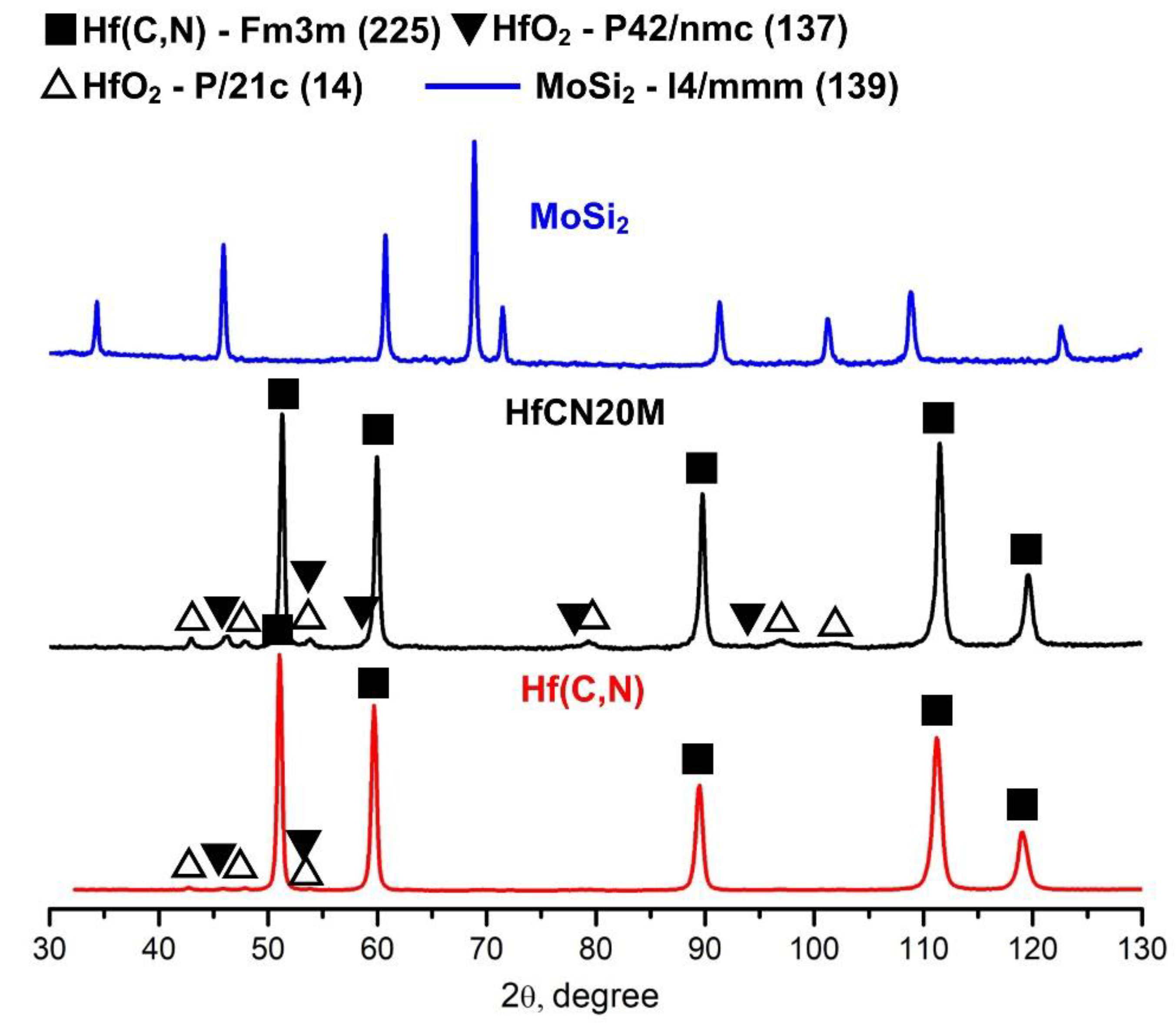
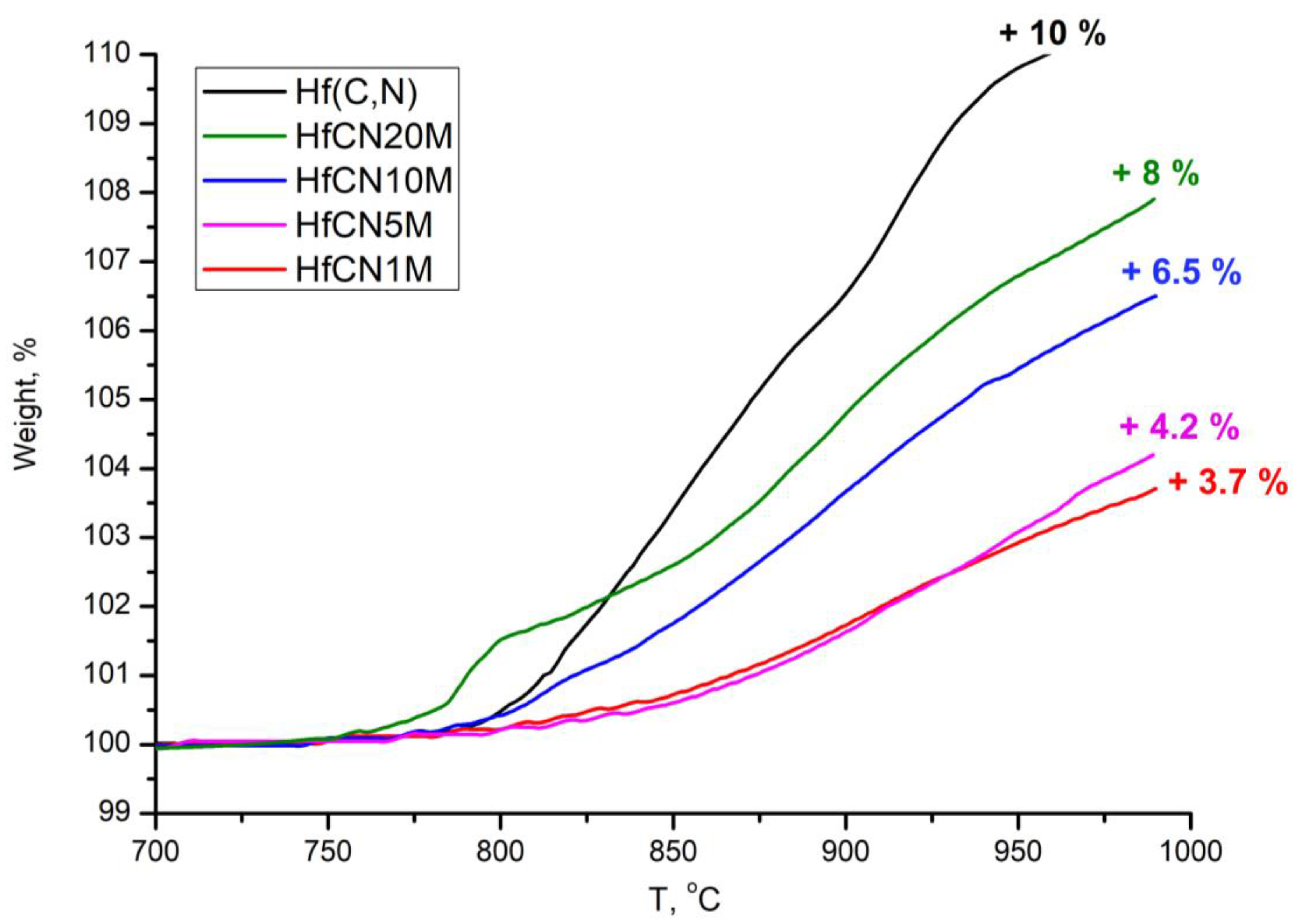
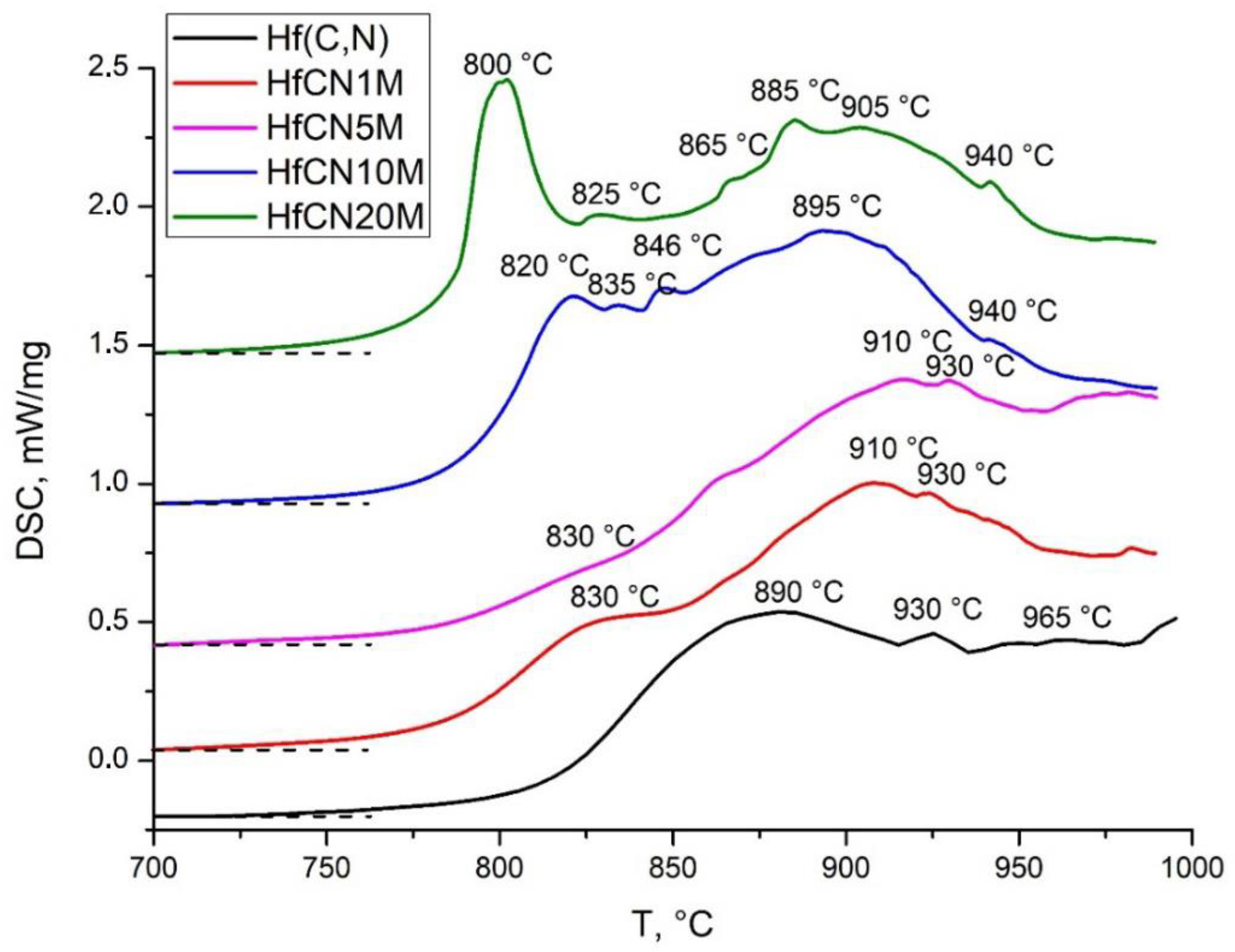
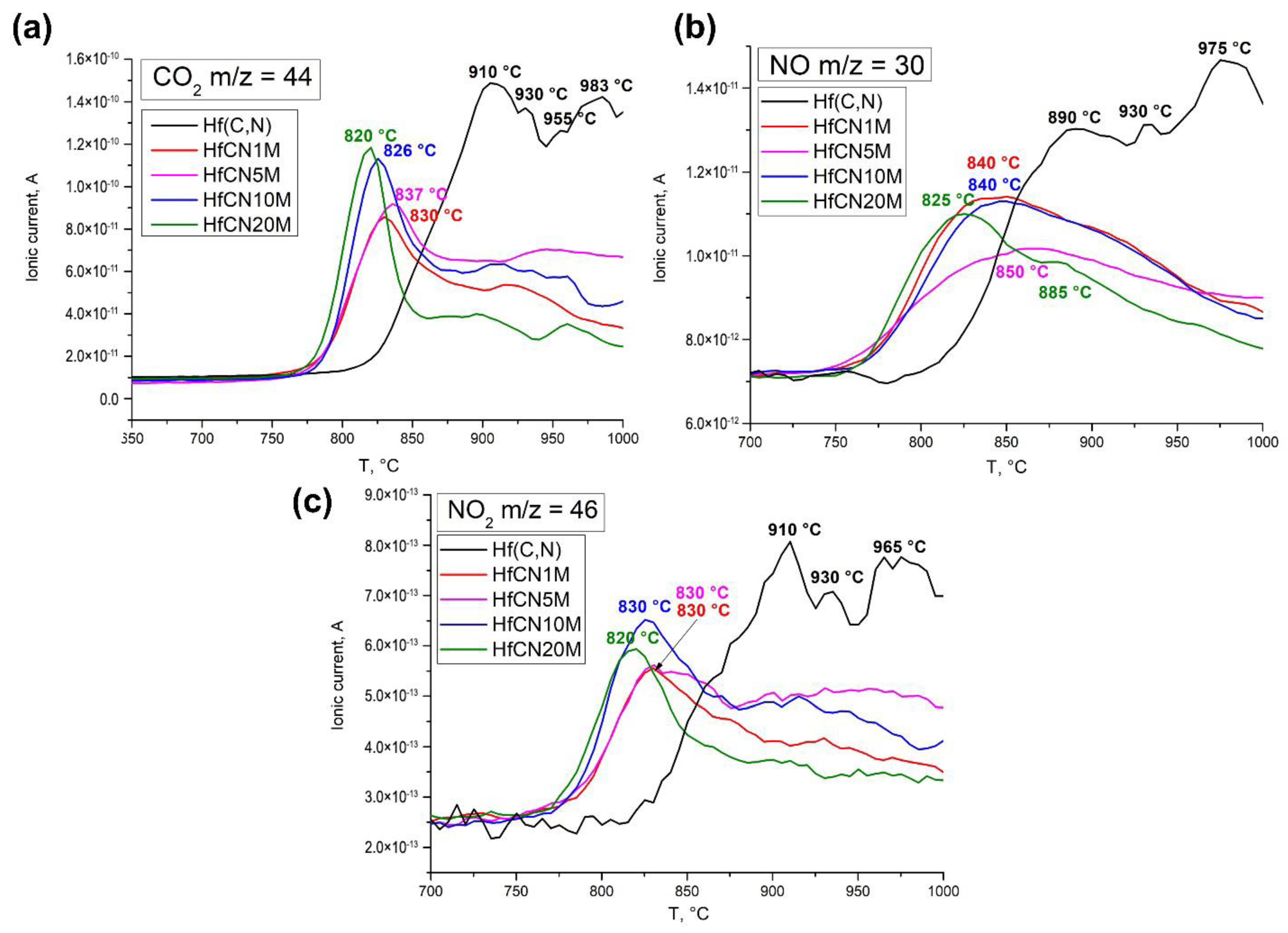

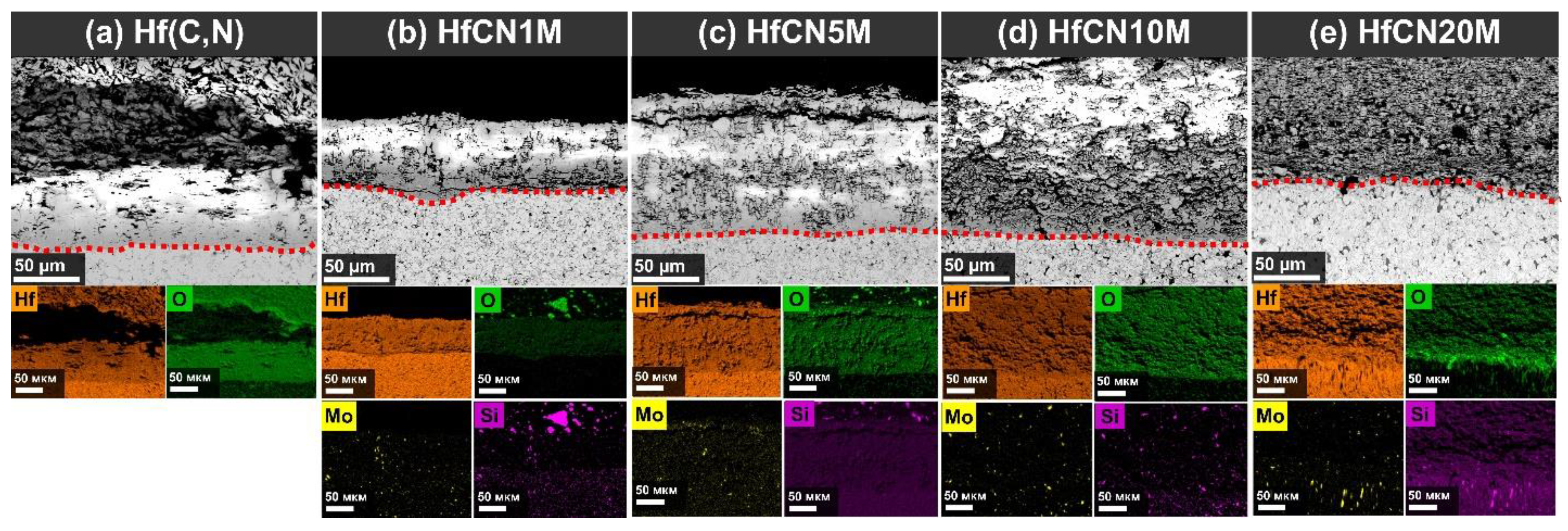
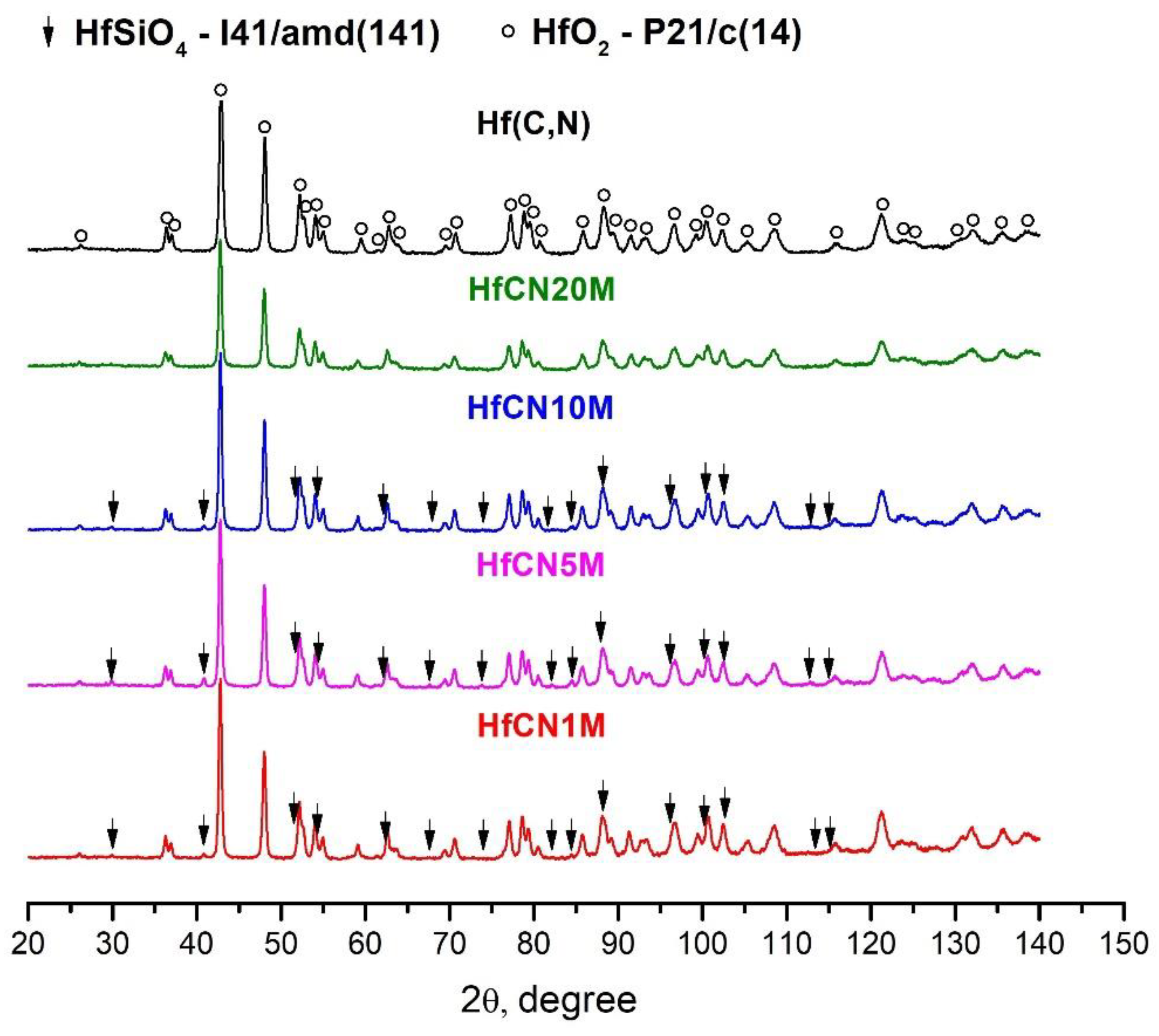

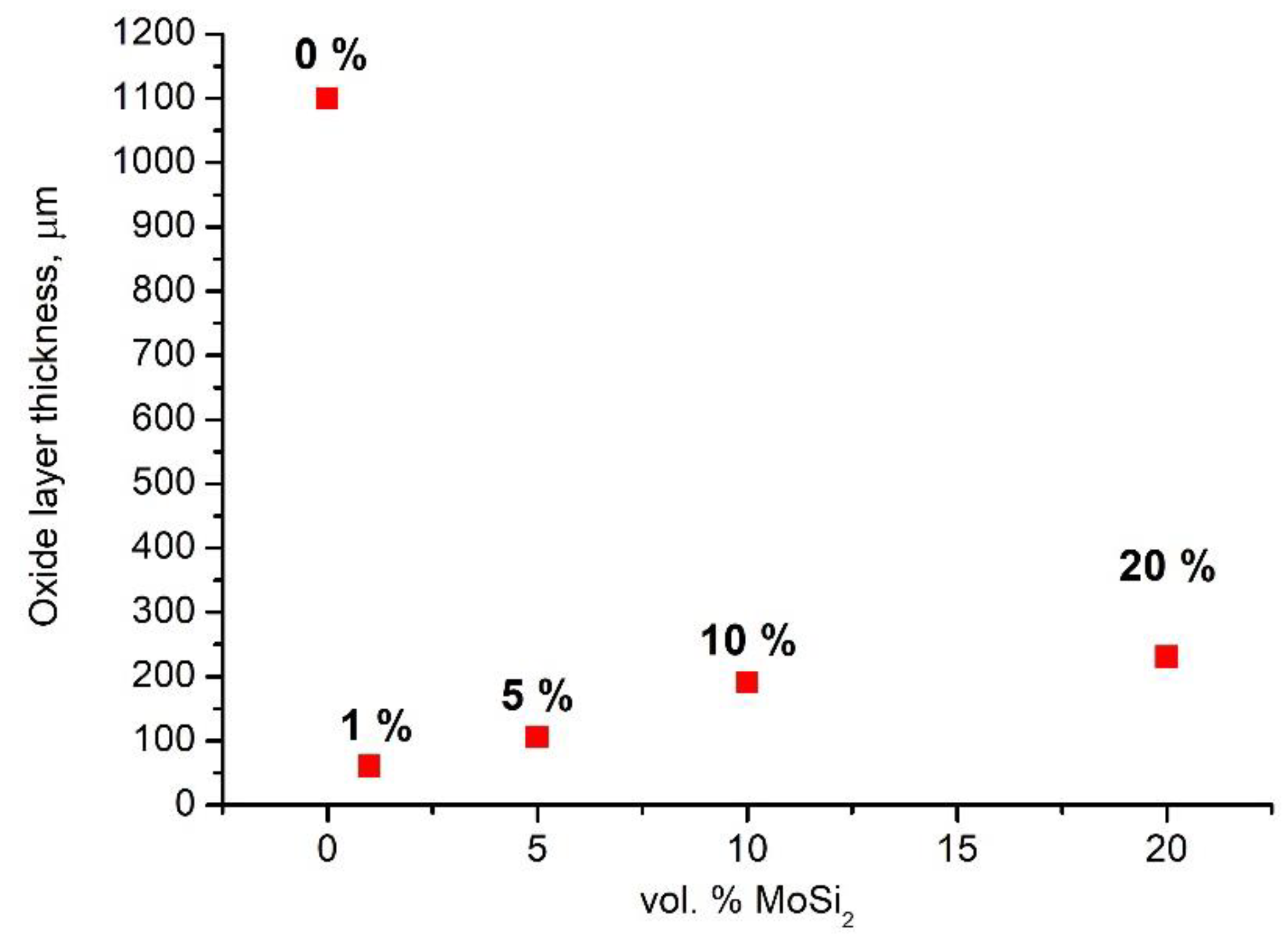
| Material | NaCl Fm3m(225) | a, nm | ||||
|---|---|---|---|---|---|---|
| (111) | (200) | (220) | (311) | (222) | ||
| Hf(C,N) | 2.6501 | 2.292 | 1.6232 | 1.386 | 1.3251 | 0.459 |
| HfCN20M | 2.6448 | 2.2905 | 1.6224 | 1.3851 | 1.3246 | 0.459 |
| Material | Relative Density (%) | ||
|---|---|---|---|
| Hf(C,N) [12] | - | 98.1 | 21.3 ± 0.55 |
| HfCN1M | 11.76 ± 0.06 | 98.6 ± 0.8 | 19.2 ± 0.3 |
| HfCN5M | 11.83 ± 0.06 | 98.5 ± 0.9 | 18.1 ± 0.2 |
| HfCN10M | 11.28 ± 0.06 | 98.6 ± 0.6 | 17.7 ± 0.5 |
| HfCN20M | 11.42 ± 0.06 | 98.2 ± 0.6 | 16.9 ± 0.3 |
| HfC + 5MoSi2 [22] | 11.80 | 93 | 17.84 ± 1.45 |
| HfC + 15 vol% MoSi2 [23] | 11.7 | 99.9 | 19.6 ± 0.5 |
| HfC+10 vol% MoSi2 [24] | 11.79 | 97.8 | 16.1 ± 0.4 |
| HfC+20 vol% MoSi2 [24] | 11.01 | 96.5 | 15.5 ± 0.9 |
| HfC+1 vol% MoSi2 [22] | 12.3 | 98.0 | 21.1 ± 0.7 |
Disclaimer/Publisher’s Note: The statements, opinions and data contained in all publications are solely those of the individual author(s) and contributor(s) and not of MDPI and/or the editor(s). MDPI and/or the editor(s) disclaim responsibility for any injury to people or property resulting from any ideas, methods, instructions or products referred to in the content. |
© 2023 by the authors. Licensee MDPI, Basel, Switzerland. This article is an open access article distributed under the terms and conditions of the Creative Commons Attribution (CC BY) license (https://creativecommons.org/licenses/by/4.0/).
Share and Cite
Suvorova, V.; Nepapushev, A.; Suvorov, D.; Kuskov, K.; Loginov, P.; Moskovskikh, D. Investigation of the Effect of Molybdenum Silicide Addition on the Oxidation Behavior of Hafnium Carbonitride. J. Compos. Sci. 2023, 7, 25. https://doi.org/10.3390/jcs7010025
Suvorova V, Nepapushev A, Suvorov D, Kuskov K, Loginov P, Moskovskikh D. Investigation of the Effect of Molybdenum Silicide Addition on the Oxidation Behavior of Hafnium Carbonitride. Journal of Composites Science. 2023; 7(1):25. https://doi.org/10.3390/jcs7010025
Chicago/Turabian StyleSuvorova, Veronika, Andrey Nepapushev, Dmitrii Suvorov, Kirill Kuskov, Pavel Loginov, and Dmitry Moskovskikh. 2023. "Investigation of the Effect of Molybdenum Silicide Addition on the Oxidation Behavior of Hafnium Carbonitride" Journal of Composites Science 7, no. 1: 25. https://doi.org/10.3390/jcs7010025
APA StyleSuvorova, V., Nepapushev, A., Suvorov, D., Kuskov, K., Loginov, P., & Moskovskikh, D. (2023). Investigation of the Effect of Molybdenum Silicide Addition on the Oxidation Behavior of Hafnium Carbonitride. Journal of Composites Science, 7(1), 25. https://doi.org/10.3390/jcs7010025








